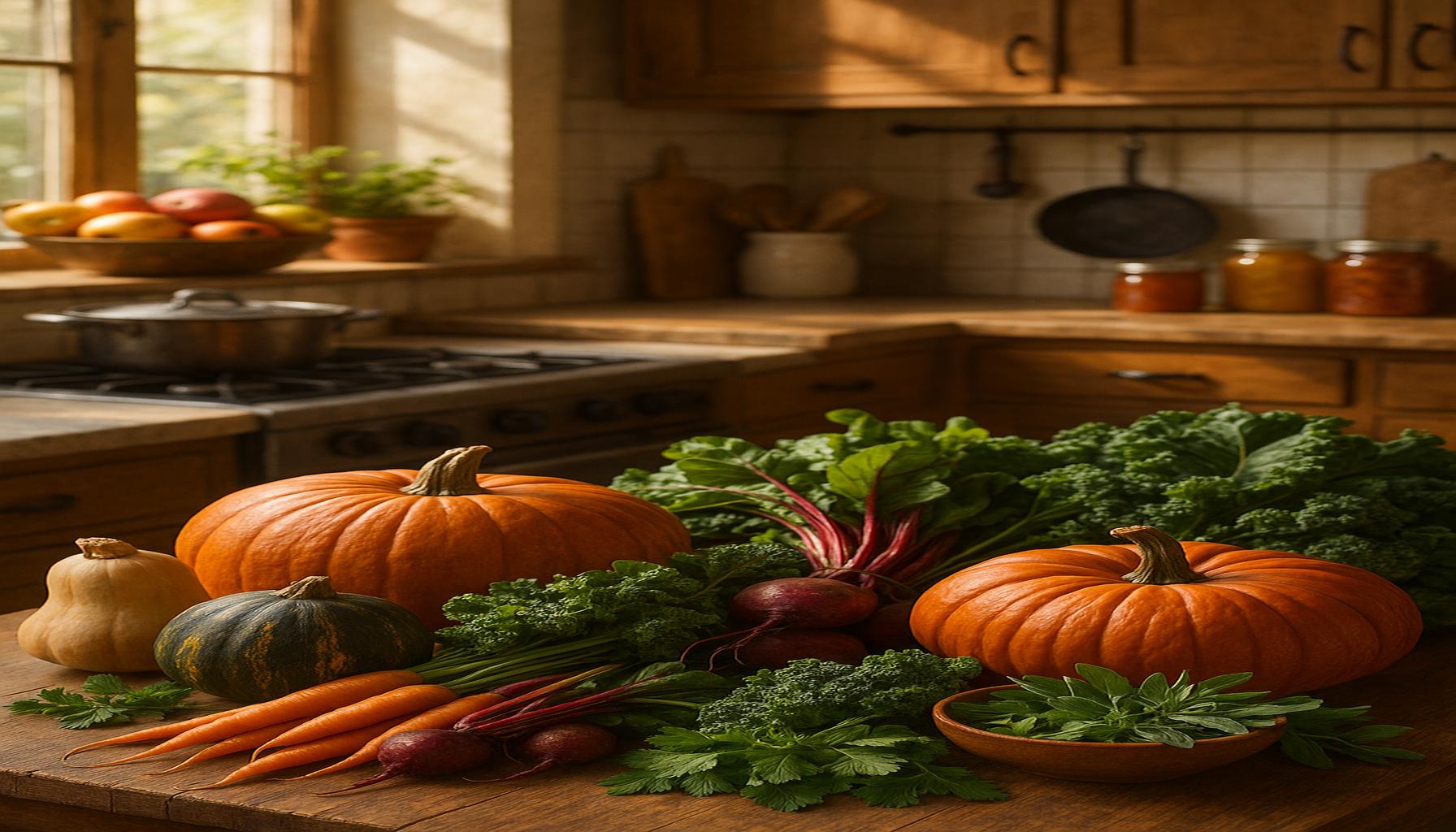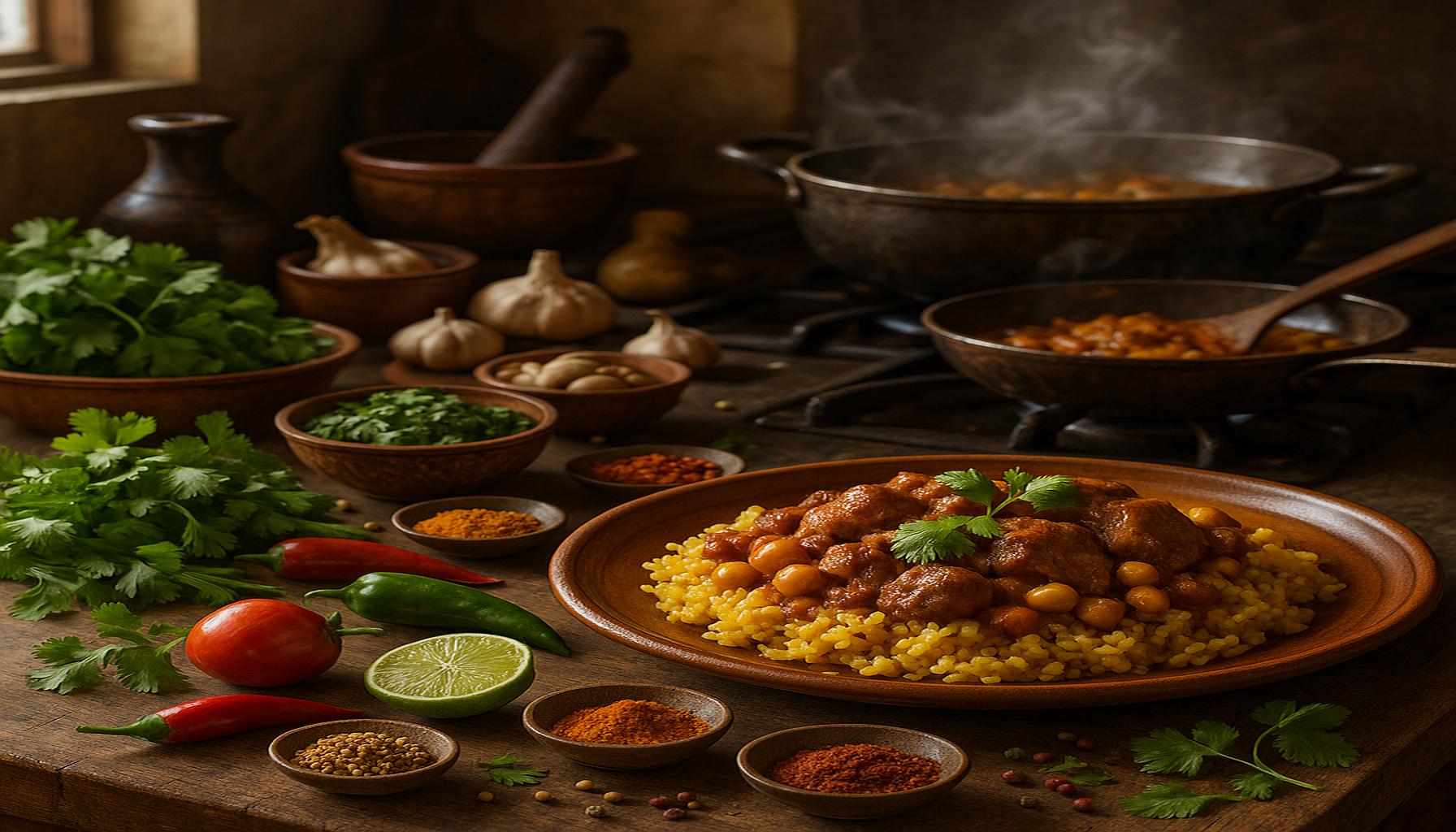Seasonal Kitchen: Exploring Recipes that Celebrate the Ingredients of Each Season

Exploring the Seasons Through Your Kitchen
Cooking with seasonal ingredients is not merely a trend; it embodies a rich tradition that honors the natural cycles of growth and harvest. Each season brings forth a vivid palette of flavors and colors, enabling cooks and home chefs alike to create dishes that truly reflect the essence of the time of year. The movement towards seasonal cooking isn’t just about what’s on your plate; it’s about fostering a connection with the land, the farmers, and our culinary roots.
One of the core principles of seasonal kitchens emphasizes:
- Freshness: Produce that is harvested at its peak not only tastes better but retains its natural flavors and nutrients. Consider biting into a sun-ripened tomato in August, bursting with sweetness and juiciness, compared to one that has traveled thousands of miles and been picked early.
- Nutritional Value: Seasonal foods are often richer in vitamins and nutrients. For example, leafy greens like kale and spinach grow quickly in spring and are packed with vitamins A, C, and K. These nutrients are vital for maintaining good health, especially during the changing seasons.
- Environmental Impact: Supporting local farmers and markets by purchasing seasonal produce reduces the carbon footprint associated with food transportation. Choosing local helps preserve farmland and supports sustainable agricultural practices, especially important in a country as vast as the United States.
As the seasons shift, the culinary landscape changes dramatically, offering endless possibilities for creativity in the kitchen. Each season provides an opportunity to experiment with flavors, textures, and cooking techniques. Below are some notable seasonal ingredients and how they inspire various dishes:
- Spring: The arrival of asparagus and sweet peas heralds the warmer months. Incorporating these ingredients into vibrant salads or light pasta dishes can celebrate the freshness of spring. Try a lemony asparagus salad topped with crumbled feta for a delightful treat.
- Summer: With the sun high in the sky, tomatoes and corn become the stars of summer-inspired meals. Local farmer’s markets overflow with varieties of tomatoes, perfect for fresh salsas or grilled with basil. Corn on the cob complemented by chili-lime butter is a quintessential summer experience.
- Fall: As the leaves change color, pumpkins and apples dominate the scene. Crisp fall afternoons are best celebrated with homemade pumpkin pie or a warming apple cider stew that captures the flavors of autumn spices like cinnamon and nutmeg.
- Winter: As frost blankets the earth, hearty vegetables like kale and squash take center stage. These ingredients can be transformed into comforting soups, stews, and casseroles, providing warmth and satisfaction during the colder months. A creamy butternut squash soup can be the perfect dish to cozy up with.
Delving into seasonal recipes allows us to develop a deeper appreciation for our food and its source. It encourages us to reflect on the rhythms of nature while also inviting creativity into our cooking. By embracing seasonal eating, we not only enhance our meals but also forge a stronger bond with our culinary heritage, supporting local ecosystems, and cultivating an awareness of what it means to eat in harmony with the earth. So, the next time you’re at the grocery store or farmer’s market, take a moment to explore the vibrant offerings of the season and let your culinary adventures begin!
DIVE DEEPER: Click here to uncover the secrets of storytelling

The Joy of Seasonal Ingredients
The allure of a seasonal kitchen lies in its emphasis on the natural rhythm of the earth, a rhythm that reflects the time-honored practices of generations past. When we embrace seasonal cooking, we open ourselves to a world of sensory delights, where the flavors of ingredients peak at just the right moment. In this section, we’ll explore some of the seasonal ingredients that define each period of the year while delving into how they can inspire our culinary creations.
Spring: A Time of Renewal
As nature awakens from its winter slumber, spring bursts forth with fresh greens and delicate produce. Crisp radishes, tender lettuce, and bright herbs like mint and cilantro mark this season. The key to celebrating spring in the kitchen is to honor the vibrant colors and freshness.
- Radishes: These peppery gems come alive in the spring, perfect for adding a crunchy bite to salads. A simple radish and butter sandwich on crusty bread is a delightful homage to this season.
- Peas: Sweet peas can be found in a variety of dishes, whether blended into a velvety soup or tossed in a salad with radishes and a tangy dressing.
- Herbs: Fresh herbs like basil and chives pop up, ready to elevate any dish with their robust flavors.
Each ingredient in spring invites exploration and innovation, encouraging cooks to create dishes that mimic the season’s vibrancy.
Summer: A Bounty of Flavor
As the sun blazes overhead, summer brings a rich variety of ingredients that speak to the heart of summer cooking. This season features an abundance of tomatoes, corn, and berries, each offering unique tastes that inspire fresh plates full of flavor.
- Tomatoes: The garden-fresh tomatoes of summer are incomparable. They can be used in everything from classic Caprese salads to rustic tomato tarts. Their juicy texture and sweet flavor are a sensational wide-reaching canvas in the kitchen.
- Corn: Sweet corn, whether grilled and slathered with butter or incorporated into salsas, brightens every meal throughout the hot months.
- Berries: Juicy strawberries, blueberries, and raspberries not only provide a sweet finish to desserts but can also be an unexpected star in savory dishes, such as summer salads or marinades.
Cooking with these seasonal ingredients ensures that every meal is a celebration of summer’s bounty and encourages creativity in both cooking and presentation. The challenge of styling these colorful ingredients can transform a simple dish into a festive feast.
Fall: A Harvest of Earthy Goodness
As the air turns crisp and the leaves change, fall ushers in a wealth of hearty ingredients that evoke warmth and comfort. This season is marked by root vegetables, squash, and aromatic spices that can create heartwarming meals.
- Squash: Varieties like butternut and acorn squash offer sweet and nutty flavors, perfect for roasting or pureeing into soups.
- Apples: As they come into harvest, apples can be used in everything from savory pork dishes to sweet pies, encapsulating the essence of fall.
- Root Vegetables: Carrots, beets, and parsnips are perfect for roasting together, creating colorful side dishes that celebrate the season’s produce.
By integrating these hearty ingredients, one can craft meals that not only nourish the body but also warm the heart during those chilly evenings.
These seasonal ingredients and their associated recipes not only highlight the natural beauty of the culinary world but also provide an opportunity for personal expression and cultural connection through food. Embracing the seasonal kitchen paves the way for an exciting culinary journey, one that connects us deeper with the Earth and its cycles.
| Advantages of Seasonal Cooking | Details |
|---|---|
| Freshness of Ingredients | Using ingredients in their peak season ensures superior flavor and higher nutrient content. |
| Support for Local Economy | Seasonal cooking emphasizes locally sourced produce, helping to sustain local farmers and reducing carbon footprints. |
| Variety in Diet | Exploring seasonal recipes encourages a diverse diet, exposing eaters to different flavors and textures throughout the year. |
| Culinary Creativity | The changing seasons inspire culinary innovation, prompting cooks to experiment with unique combinations and cooking techniques. |
The concept of a Seasonal Kitchen invites food enthusiasts to discover recipes that vibrantly showcase the best of nature’s bounty as it shifts through the seasons. This approach not only enhances the dining experience but also cultivates a deeper understanding of food, its origin, and its impact on health. Engaging with seasonal ingredients can motivate home cooks to embrace flavors they may overlook, introducing them to ingredients that appear briefly and are worth savoring. This journey through the seasons not only nourishes the body but also nurtures a connection to the earth’s cycles, fostering a richer culinary adventure.
DISCOVER MORE: Click here to elevate your culinary presentation
Winter: A Time for Comfort and Nourishment
As winter descends, it brings with it a unique palette of ingredients that invite us to create hearty, soul-warming meals. Winter is a season for embracing robust flavors, from savory root vegetables to the citrusy brightness of seasonal fruits. This time of year encourages slow cooking, with meals designed for sharing and savoring, bringing warmth to both body and spirit.
Root Vegetables and Greens
In the depths of winter, the earthy tones of root vegetables take center stage. Vegetables like carrots, parsnips, and sweet potatoes shine in comforting dishes. Their natural sweetness can be highlighted in roasts or soups, providing a delightful balance to winter meals.
- Sweet Potatoes: Rich in vitamins and fiber, sweet potatoes can be mashed, roasted, or turned into creamy soups. They pair beautifully with spices like cinnamon and nutmeg, enhancing their natural flavors.
- Brussels Sprouts: These nutrient-dense greens are perfect for roasting. Toss them with a drizzle of balsamic glaze and serve them alongside hearty grains for a warm winter salad.
- Beets: Roasted beets can add vibrant color and an earthy flavor to dishes. They can be used in winter salads, or even blended into a nutritious dip.
Utilizing these root vegetables not only taps into their rich flavors but offers an opportunity to create meals that resonate with winter’s spirit of warmth and comfort.
Citrus Fruits to Brighten the Dark Days
Winter is also the season for citrus fruits, which provide a refreshing burst of flavor amidst the cold. Oranges, grapefruits, and lemons can brighten up dishes and are essential for adding zest to palatables that might otherwise feel heavy during the colder months.
- Oranges: These versatile fruits can elevate a simple winter salad or transform roasted vegetables with a splash of orange juice and zest.
- Grapefruit: The slight bitterness of grapefruit complements sweet and savory dishes alike, making them an intriguing addition to tart dressings or marinades.
- Lemons: The acidity of lemon juice can cut through rich winter dishes, adding brightness to creamy soups or roasted meats.
Incorporating citrus into your winter recipes not only enhances flavors but also aligns with the seasonal theme of utilizing fresh produce available at this time.
Seasonal Comfort in Cooking Techniques
Winter cooking invites a more leisurely pace, making it the perfect time for techniques that warm the home. Slow cooking and braising allow for flavors to develop and meld beautifully, creating meals that are both nourishing and satisfying. Try whipping up a hearty beef or lentil stew, where ingredients simmer together until tender.
- Casseroles: These hearty dishes are comforting staples during winter. Combine grains, proteins, and seasonal vegetables for a one-dish meal that warms you from the inside out.
- Soups: Everything from classic chicken noodle to creamy squash soup shines this season. A steaming bowl of soup can be a delightful remedy against the winter chill.
Throughout the winter months, the emphasis on ingredients that provide nourishment and comfort creates a unique culinary landscape. Embracing what winter offers ensures that each meal not only showcases the season’s bounty but also nurtures the soul.
DISCOVER MORE: Click here to dive into ethnic cuisine
Embracing the Rhythm of the Seasons in Your Kitchen
As we journey through the culinary landscape of each season, it becomes clear that nature provides us with a rich tapestry of ingredients designed to nourish not just our bodies, but our spirits as well. By embracing the seasonal kitchen concept, we can create meals that reflect the changing rhythms of the year—from the refreshing greens of spring to the hearty comfort of winter root vegetables. Each season presents unique opportunities to explore crisp, bright flavors or indulge in the warmth of slow-cooked dishes.
Utilizing seasonal ingredients means more than just enhancing flavor; it fosters a deep connection to our food sources and encourages sustainable practices. Incorporating fresh, locally-sourced produce into our meals showcases the best of what nature has to offer, supporting farmers and reducing our environmental footprint. Moreover, seasonal cooking brings excitement and diversity to our dining tables, allowing us to experience a variety of flavors and textures throughout the year.
As you explore recipes that celebrate these ingredients, consider how each season invites its own set of traditions, flavors, and cooking techniques. Whether it’s crafting a vibrant salad using spring’s early shoots or savoring a warming stew in the depths of winter, the seasonal kitchen offers a delightful journey worth embarking on. Ultimately, celebrating seasonal ingredients nurtures our culinary creativity, fosters health, and cultivates a deeper appreciation for the world around us. So, step into your kitchen and embrace the beauty of each season through the power of food.


